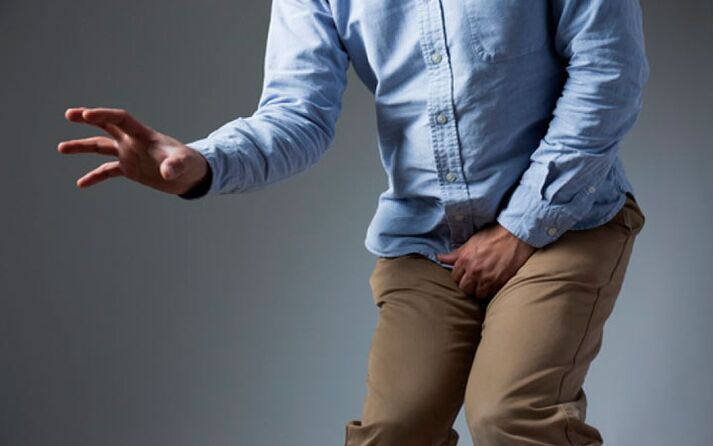Prostatitis can affect effectiveness or cause infertility. The success of treatment depends to a large extent on the speed at which treatment is started, so men must independently pay attention to the first signs. Consider how prostatitis manifests in acute and chronic forms, and provide information about clinical manifestations and symptoms.

Signs of acute and chronic prostatitis
Acute prostatitis is most common in sexually active men of childbearing age. In this case, the first signs of the disease are unexpected and develop rapidly and cannot be ignored.
With acute prostatitis, men will feel:
- Severe, often throbbing pain in the perineum;
- The temperature rises to 39°C;
- Pain when urinating.
For diseases, the focus of the inflammatory process of the prostate is extensive, and therefore, nearby organs may be involved in the pathological process. For example, prostatitis can affect the rectum and cause painful bowel movements.
Chronic prostatitis is more common in men at retirement age. This disease can continue to develop without any special symptoms. Sometimes patients complain to the doctor of burning or itching when urinating, and notice mucus or purulent discharge from the glans. The pain of chronic prostatitis is absent or not obvious, and the temperature rises to 37 degrees.
Initial symptoms
The doctor identified many manifestations that are considered to be precursors of the disease. They are a signal for a man to see a doctor in the near future. The six symptoms listed below indicate problems with the genitourinary system and are therefore combined into one group-dysuria syndrome:
- The urine is discharged in drops, and the man works hard for it.
- The jet is slow and the range does not exceed 20 cm.
- Urine splashes, water flow splits, or unconsciously interrupted.
- I often want to go to the toilet at night.
- Pain when urinating.
- The feeling of empty bladder.
If there is only one symptom-prostatitis, it is likely that we are not talking about it. However, if a person can notice two or three signs of oneself, this is the reason to consult a doctor. Most likely, the inflammatory process of the prostate has already begun.

The doctor will make a more accurate diagnosis after comprehensive examinations such as rectal examination, TRUS, and laboratory methods. It is also necessary to choose treatment methods based on the results of these measures, so self-administration is strictly prohibited.
Urination problems may indicate prostate cancer, so treatment strategies will be fundamentally different.
Certain manifestations do not always indicate prostatitis; they may indicate any other inflammatory process in the genitourinary system. However, when they appear, we have reason to be vigilant. Consider how a person feels if he has inflammation in his prostate.
Violation of urination
In patients with acute prostatitis, the urination process is disturbed. Under normal circumstances, a man can feel the urge to relieve small needs up to 15 times a day, which is caused by drinking habits. Average index-4-5 times. However, with prostatitis, the situation changes. A man may feel this impulse twice as often, but the urine output will not increase. This means that the kidneys are working normally, but the bladder wall is compressed by the prostate.
The narrowing of the prostatic urethra leads to drenching in urine. This is a pathological condition in which men experience severe pain when urinating. The development of ischuria is also possible (inability to go to the toilet).
Temperature rise
The first sign of acute prostatitis is an increase in body temperature to fever level (38-39 degrees). This symptom is a special feature of purulent prostatitis and a precursor to septic shock. As the serious infection process progresses, body temperature can drop to 35-36°C.
In some cases, this situation can be life-threatening. It is especially dangerous for men with dsemulated intravascular coagulation syndrome.
Blood in the urine
This symptom is more often detected in laboratory urine studies, and is rarely detected visually by men themselves. This is a dangerous manifestation of prostatitis, which is difficult to combat. The cause of hematuria (the scientific name of the trait) can be:
- The location of the blood vessels in the area of the purulent inflammatory process;
- The development of prostate cancer or adenoma;
- Causes trauma to the urethra or prostate during the examination.
In addition, calculous prostatitis may also have this manifestation, because stones and sand can damage the glandular tissue. Fortunately for men, hematuria caused by prostatitis is very rare.
Groin pain syndrome
Acute prostatitis and chronic forms of complications can be accompanied by different types of pain, ranging from moderate to severe. This is not the first sign of prostatitis, but it cannot be ignored. Distinguish between the following types of discomfort:
- Shooting, severe pain;
- Pain or pressure;
- Itching and burning (more common in chlamydial prostatitis).
In some cases, men may also experience pain in the anus. In the sitting position, it will increase with defecation, and it will disappear if the man is at rest.
Laboratory signs of the disease
Only by examining blood and urine in the laboratory, and based on the results of ultrasound, CT, MRI, and palpation, can it be said that a man has started prostatitis. There are several known signs that can build up inflammation in organs:
- The appearance of white blood cells in the blood and urine;
- Identification of pathogenic bacteria in urine and prostate secretions;
- In the context of the decrease in the number of lecithin particles in the prostate fluid, the number of white blood cells increases;
- Soreness in the prostate area during rectal examination;
- The size of the glands on the TRUS image increases, and there are areas with increased echo.
In addition, the presence of inflammation in the body can be judged by other parameters-the increase of ESR in the blood test, the change of white blood cell diagram, the presence of immobile sperm in ejaculation.
Various bacteria can be found in urine-Trichomonas, Chlamydia, Escherichia coli, etc.
From the perspective of instrumental methods, in addition to TRUS, X-ray inspection with contrast agents can also be involved. In the prostate pictures of different projections, signs of inflammation will be clearly visible-the area of tissue structure disorder.
in conclusion
From a practical point of view, the following first signs of prostatitis are important for men-poor urination and perineal pain. If the body temperature rises at the same time, it can be said to be acute bacterial prostatitis.
In any case, you will need to make an appointment with your doctor and undergo an examination before you can start treatment. It is forbidden to choose one's own treatment, and only pay attention to unpleasant performance.
























